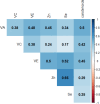Joint and independent associations of dietary antioxidant intakes with all-cause and cardiovascular mortality among patients with hypertension: a population-based cohort study
- PMID: 39856716
- PMCID: PMC11761209
- DOI: 10.1186/s12937-024-01062-9
Joint and independent associations of dietary antioxidant intakes with all-cause and cardiovascular mortality among patients with hypertension: a population-based cohort study
Abstract
Background: The evidence regarding dietary antioxidant intake and all-cause and cardiovascular disease (CVD) mortality among patients with hypertension is scarce.
Methods and results: This study included 16,190 adults with hypertension from the National Health and Nutrition Examination Survey (NHANES) 1999-2018. Death outcomes were ascertained by linkage to National Death Index records through December 31, 2019. Overall dietary intake was estimated with composite dietary antioxidant index (CDAI). Cox proportional hazards models were used to estimate the risk for all-cause and CVD mortality. Kaplan-Meier curve was used to illustrate the survival probabilities among CDAI quartiles. Weighted quantile sum (WQS) regression was conducted to evaluate the joint and independent associations of antioxidants with all-cause and CVD mortality. The median (interquartile range) age of participants was 59.00 (47.00, 69.00) years. During a median of 94 months of follow-up, 3,858 deaths were documented. Compared to participants with the lowest quartile of CDAI, the multivariable adjusted HR and 95% CI for participants with the highest quartile was 0.76 (0.64, 0.91) for all-cause mortality. The highest quartile (Q4) of vitamin E (HR = 0.69; 95% CI, 0.59-0.80), selenium (HR = 0.84; 95% CI, 0.70-1.00) and total carotenoids (HR = 0.86; 95% CI, 0.75-0.98) intakes were negatively associated with all-cause mortality. Vitamin E and selenium intakes might be the major contributors to this negative relationship. The highest quartile (Q4) of vitamin E (HR = 0.72; 95% CI, 0.56-0.93) intake was negatively associated with CVD mortality.
Conclusion: Higher overall dietary antioxidant intake was significantly associated with decreased all-cause and CVD mortality among patients with hypertension. Further randomized controlled trials are required to confirm our findings.
Keywords: CVD mortality; National Health and Nutrition Examination Survey (NHANES); all-cause mortality; antioxidants; composite dietary antioxidant index; hypertension.
© 2024. The Author(s).
Conflict of interest statement
Declarations. Ethics approval and consent to participate: The Ethics Review Board of the National Center for Health Statistics (NCHS) granted approval for the survey protocol. Written informed consent form was obtained from all participants. Competing interests: The authors declare no competing interests.
Figures
References
-
- NCD Risk Factor Collaboration. Worldwide trends in hypertension prevalence and progress in treatment and control from 1990 to 2019: a pooled analysis of 1201 population-representative studies with 104 million participants. Lancet. 2021;398(10304):957–80. 10.1016/S0140-6736(21)01330-1. - PMC - PubMed
-
- Olsen MH, Angell SY, Asma S, et al. A call to action and a lifecourse strategy to address the global burden of raised blood pressure on current and future generations: the Lancet Commission on hypertension. Lancet. 2016;388(10060):2665–712. 10.1016/S0140-6736(16)31134-5. - PubMed
-
- Massaro M, Scoditti E, Carluccio MA, De Caterina R. Oxidative stress and vascular stiffness in hypertension: A renewed interest for antioxidant therapies? Vascul Pharmacol. 2019;116:45–50. 10.1016/j.vph.2019.03.004. - PubMed
MeSH terms
Substances
Grants and funding
LinkOut - more resources
Full Text Sources
Medical




